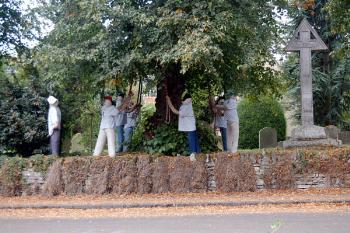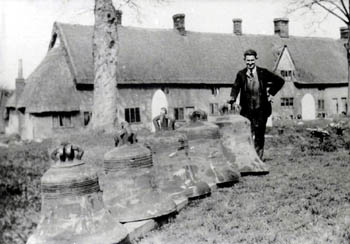Stagsden Church Repairs and Additions

Sinister scarecrows in Stagsden churchyard September 2007
Most of the notes on the structural history of the church can be found in greater detail in Bedfordshire Historical Record Society Volume number 79 of 2000 Bedfordshire Churches in the Nineteenth Century: Part III: parishes S to Y, put together by former County Archivist Chris Pickford from numerous sources some held by Bedfordshire & Luton Archives & Records Service and some held elsewhere or published.
The first record of the fabric of Saint Leonard's church after the Middle Ages was in 1552 when it was reported that the church had a lead coated steeple and that the chancel was covered by lead and slate, the church had four bells. The church now has five and three of these date from the 17th century (two from 1652 and one from 1684). In 1668/9 it was reported that the chancel windows needed glass and six years later that the chancel was "out of repair". In 1769 a bell was either recast or added.

the church interior in the late 19th century [Z50/107/35]
In 1825 a new communion cup was purchased by the parish. In 1833 Archdeacon Bonney noted that the church was "under thorough repair both internally and externally" and church records show an expenditure of £92 in 1833/4, then a large sum which it can be assumed was caused by some form of construction work. The following year the church was struck by lightning and further repair work followed in 1839 and 1842, one of the bells being recast in 1844.
WA was the pseudonym of John Martin, librarian of Woburn Abbey. Either side of 1850 he wrote a series of articles for the Northampton Mercury deploring the state of churches in Bedfordshire. These are usually pompous, snide and splenetic by turn. Stagsden was in his cross-hairs in the edition of 21st August 1847: "The difficulty in obtaining a view into this church was considerable. the churchyard is not only locked, but the gates have spikes on top lest any unhappy tourist, or it may be relative of the departed, should attempt to scale the gates to inspect the grave-stones. When, however, the janitor is found you will perhaps have to wait whilst he makes his bargain fo a fee in opening the gates of the church, which has been emphatically stuled as that of the poor man. Having concluded your bargain, the first set of gates is opened, not a wicket as is usually the case, but stern, repulsive prison doors. Then you attend the church gates themselves. After all the chaffering for admission, and throwing open the various obstacles, you would naturally expect to be introduced into some very beautiful specimen of church architecture, admirably arranged, and in high preservation. Bitter will be your disappointment, for you will witness the ravages of damp and dirt most extensively, and the whole fittings-up in a very disgraceful condition. The chancel is ceiled, well plastered, a common brick floor, and all in a very neglected condition".
"Worn-out matting, a ruined prayer-book rotting on a bracket, the window a repository for the tattered books of a Sunday school, the children of which we presume receive their first lessons, pf order and decency, and reverence of Holy things, in this quarter. Some stall sittings are in a very dirty state. The upper part of the chancel-arch is boarded up, built on the remains of the rood screen. the nave has a trimber roof. The pulpit and reading-desk are wrongly placed: There are some open sittings mingled with enclosed boxes. The western window is shut out. There are festoons of hat pegs. the panelling of the rood screen is hidden by two large square pews erected close to it".
"The niches in the south aisle are plastered over, and destroyed without remorse to let in wood-work for suspending hats. The flooring is common brick. The remains of an alms-box are a sufficient comment on the rest of the neglect exhibited in this church".
"The font has its drain and lining, but is not used. The columns are all plastered. The windows of the porch are blocked up. The chancel-roof is tiled, but lead remains on the nave and aisles".
The main 19th century restoration occurred between 1848 and 1850 when William Stephen was vicar, the builder being Jobson Jackson of Bedford; a sketch of 1850 shows the church roof had been removed. The bells were re-hung in 1856 and the spire may have been restored in the same year. £200 was spent on church repairs in 1870 and about that time a second-hand organ was obtained from Bedford, St.Mary's with a clock being installed in the tower two years later. Two years after that, in 1874, the east window was filled with geometrical glass as a memorial to Charles Bass.
During W. H. Jackson's tenure as vicar a number of improvements and alterations were carried out. Painted texts were added to the walls in 1884 and 1887 and in the latter year new fittings were installed in the sanctuary and chancel. A new brass lectern was purchased in 1895 and the vestry was enlarged the following year.

The church bells during restoration in 1932 [Z50/107/25]
In 1906 a violent hail storm damaged the west windows. In 1908 the church was redecorated internally. The bells were restored in 1932 and furnishings were added to the east end of the south aisle as a chapel dedicated to Madeleine Bonavia Hunt in 1937. Noel Bonavia Hunt, the vicar from 1937 to 1956 was a noted expert in church organs. Stained glass windows were inserted into the windows of the south aisle in 1949/50 and the organ enlarged in 1948 and again in 1977.